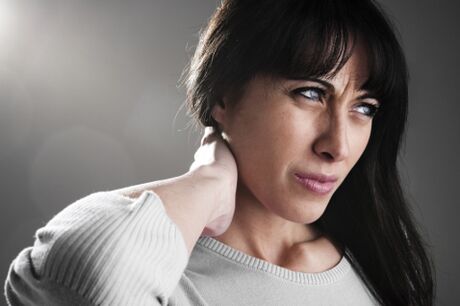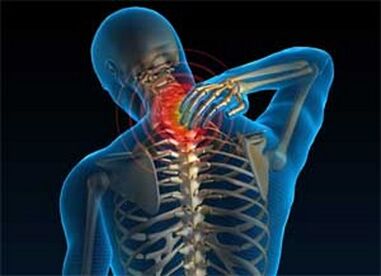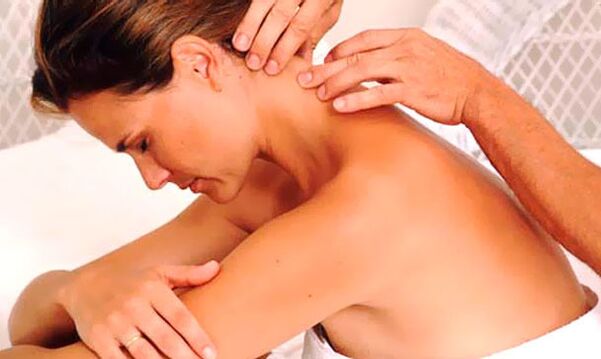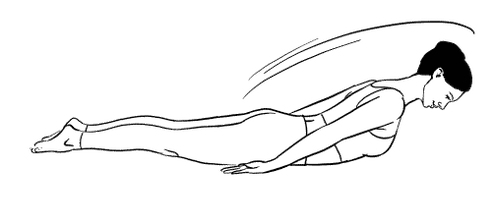
It is very sad to understand, but at the moment, almost all people who have reached the 25th anniversary suffer from cervical vertebra osteochondrosis.In cervical vertebra, this disease is more common, compared to other spinal departments.So this topic is very important in the modern world.
We will tell you why osteochondrosis occurs, how you manifest and how to treat it.
Let us also consider which drugs work most effectively, and give an example of the exercises needed to treat this disease.
The cervical spine osteochondrosis is a degenerative process in the intervertebral discs, which significantly reduces their height in the cervical spine.It leads to changes not only to the intervertebral discs, but also to the vertebrae and nodes of this department.
Causes of osteochondrosis of the cervical region
The factors will be listed just below, as a result of which the pressure on the cervical spine increases.To offset this, the neck muscles try to shift the excess load, and as a result there is a spasm and circulatory disorders in the area, which involves degenerative changes.
Causes of cervical osteochondrosis in men and women (factors affecting the development of cervical spine osteochondrosis):
- violation of the behavior or bending of the spine;
- Excess weight;
- Hippodynamia is a sedentary lifestyle (for example, sitting with a driver, office workers);
- trauma or spinal cord damage;
- Points in metabolism:
- regular physical activity;
- stress or unstable psycho -emotional state;
- The physical condition of the muscle is insufficient;
- Was inherited by parents;
- Constant holding the phone with a shoulder;
- Development of abnormalities in the cervical spine.

The causes of osteochondrosis of the cervical spine have worsened only without medical intervention in time.
The development of cervical osteochondrosis
The rate of osteochondrosis is not its stage at all.Determined based on the words of the patient and the general clinical appearance.We will get to know the stages a little later.
SO:
First degree
Minimal manifestations, the patient complains of a poor pain in the cervical region, which intensifies if you turn your head.When examined, it can be concluded that the cervical muscles are slightly tense.
The second degree
Pain in the cervical back becomes much stronger.It can spread to the shoulders and arms.This is explained by the fact that the height of the intervertebral disc is reduced and the nerve roots are violated.The pain increases when a person bends or turns his head.The patient is concerned about headaches, persistent weakness and even reducing performance.
The third degree
Clear symptoms of osteochondrosis manifest themselves stronger and are regularly present.Common pain in the arm or shoulder can cause the nobility of the upper limbs and weakening the muscles due to the formation of intervertebral hernia.Constant weakness and dizziness.On examination, it can be revealed that the cervical spine becomes less mobile and pain during the feeling of this page.
Fourth degree
The intervertebral disc is completely destroyed, which now replaces connective tissue.Dizziness intensifies, noise occurs in the ears, coordination is disturbed, as the vertebral artery leads to the brain and occipital of the brain is affected.
The irritation of the cervical osteochondrosis is extremely dangerous due to the small size of this department and great importance to the entire body bone apparatus.The slightest displacement of vertebrates can lead to the compression of the most important nerve endings.And educated osteophytes at a later stage will lead to even worse consequences for blood vessels and nerves.A negative outcome can be a hernia or extension of the spine, which is why the nerve pole swells, and then inflammation.As complications of cervical osteochondrosis, this is compression of the spinal cord.The loss extends not only to the neck and head, but also to the limbs (initially at the top).
What are the symptoms of cervical osteochondrosis?
The cervical spine osteochondrosis is very different in its symptoms from such a disease to other parts of the spine.This can be explained by the fact that in this part of the spinal column, a very small distance between the vertebrae, which means that with the slightest pathology nerve endings and spinal cord are immediately.

The most common symptoms of cervical and chest spine osteochondrosis:
- Pain can be located both in the neck and the back of the head, shoulder or even hand.Pain in the occipital part of the head is caused by muscle spasms, which are adjacent from the neck to the occipital bone and cause disturbances in the bloodstream.The sensations of pain in the shoulder or upper limb are due to the attraction of nerve endings that supply the muscles of these parts of the body.
- Weakness in the hands.It is the result of damage to the nerve responsible for movement, the inner muscles of the hand.
- Reducing the sensitivity of the hand.It appears when the process damages the nerve, which provides sensitivity to the skin of the upper limbs.
- Movement in the cervical spine in the cervical spine is limited, cramping when moving the neck.It is explained by the fact that the height of the intervertebral disc is reduced, bone growths appear in the body of the vertebrae and small joints in the intervertebral space is affected.
Symptoms of cervical osteochondrosis that arise in the brain are expressed by impaired weakness, dizziness and coordination.These symptoms appear when the vertebral artery is involved in the process, which passes through its canal located in the holes of the transverse processes of the cervical vertebrae.Due to the development of cervical osteochondrosis, forms of fibrous tissue, the vertebrae has been displaced, the blood flow to the arteries worsens, which leads to a deterioration in blood supply in the occipital area of the brain and cerebellum.
- The numbness of language, loss of hearing and vision.Symptoms of an advanced form of cervical osteochondrosis, when blood flow to the occipital part of the brain, brain and trunk worsens strongly.
A lump in the throat with osteochondrosis of the cervical spine is very common and not very specific.Many people take it for a cold symptom and fight it with warmth, rinsing and medicine.But these are not those methods of war, so relief does not happen.Most often, hardening of the discomfort occurs at night, and patients crawl in fear that the rest of the air cannot be absorbed.
The main symptoms of cervical osteochondrosis are pain, weakness in the hands, restriction of movements in the cervical region, dizziness, impaired coordination and numbness of the tongue.
Such symptoms of cervical osteochondrosis in women and men should not be ignored.When they occur, you should visit neurology immediately.
Osteochondrosis cutter of the cervical
Key Diagnosis Methods:
- X -Ray of the cervical spine.Not a particularly informative way, especially in the advanced phase of osteochondrosis.
- Calculated tomography.It shows shifts in the beads, but it is difficult to decide the presence and size of the intervertebral hernia, as well as determine the pressure of the hernia in the spinal cord.
- Magnetic resonance tomography.The most informative way.You can see not only the bone structure but also the intervertebral discs, the presence of a hernia, its size and direction of growth.
- Double scan of blood vessels.It is applied if there is a suspicion that the bloodstream is disturbed in the vertebral arteries.Using this method, it is enough to simply determine changes in the speed of blood circulation and quickly identify the obstacles in its path.
Stages X -Ray of cervical osteochondrosis:
Phase I - small changes in the arrangement of vertebrae, cervical lordosis of the spine softens;
II Stage - the instability between the vertebrae appears, one spine against another can be moved, the thoros is not excluded - the rotation of the vertebrae around the axis, the height of the intervertebral disc is slightly reduced;
Phase III - a general decrease in height between the intervertebral discs is ¼, arthrosis of the intervertebral joints and osteophytes is formed, the intervertebral holes and the spinal canal are reduced, where the spinal cord is placed;
Phase IV - the height of the intervertebral disc is significantly reduced, the arthrosis of the intervertebral joints, very large osteophytes are actively developing, the intervertebral holes and the spinal canal, with the development of myelopathy, decrease greatly.
Treatment of cervical osteochondrosis

The main methods of treatment of cervical osteochondrosis are treatment with medicines, physiotherapy, cervical-muscular massage and a very effective therapeutic gymnastics.
Below are the drug groups used in the treatment of cervical back osteochondrosis:
- Non -inflammatory drugs non -inflammatory -help to cope with pain, relieve aseptic inflammation of the joints and damaged nerve root edema;
- Vitamin B - to regulate metabolism in nerve tissue;
- Medicines that normalize the rheological properties of blood and blood circulation;
- Chondroprotectors - drugs that restore cartilage tissue to a damaged intervertebral disc;
- Musorexants are medicines that eliminate muscle spasm.
Attention!The medicines listed are presented for recognition and in no case begin -Memication!
The main methods of treatment of cervical osteochondrosis are treatment with medicines, physiotherapy, cervical-muscular massage and a very effective therapeutic gymnastics.
Physiotherapy
Auxiliary treatment of cervical spine osteochondrosis cannot be represented without physiotherapeutic procedures.
Medicinal electrophoresis - under the influence of electricity, medicinal substances penetrate the necessary part of the body.
Ultrasound - guarantees the removal of inflammation and relief of pain, accelerates metabolic processes in the treatment area.
Magnetotherapy - relieves tissue edema, thus anesthesia the effect of exposure.
Laser therapy - with the help of light flow, inflammation is removed and blood circulation is normalized.
Physical education

Physical physical education is not a drug that can only be cured osteochondrosis.This technique is used only at the recovery phase, after the treatment of medication or physiotherapy is over.When performing exercises, a person should not feel discomfort or pain.
Exercise Number 1
In a lying position in the stomach, resting with both hands on the floor, raise your head and torso, your back all this time is straight.Linger in this position for 2 minutes.See you slowly down, repeat-2-3 times.
Exercise Number 2
In the position lying in the stomach, stretch your hands along the body, turn your head to the left, touch the floor with your ear, the same on the right side, repeat-6-7 times on each side.
Exercise Number 3
Sitting position.In inspiration - a slope forward, trying to touch the chest with his head.At the return return and jump back, repeat-10-15 times.
Exercise Number 4
In a sitting position.Put the palms on your forehead, pressuring it and pressing your forehead in your palm.The duration of the exercise is 30 seconds, repeating-2-3 times.
Exercise Number 5
Slow circular movements of the head, first to the right, after the left.10 rotations for each direction.When dizziness occurs, you should stop the exercise immediately.
Physical physical education is used only at the recovery phase, after the treatment of medication or physiotherapy is over.It is important that when performing exercises, a person should not feel discomfort or pain.



















